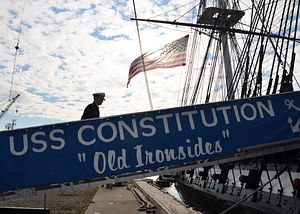So the Naval Diplomat Family spent a glorious Friday cruising Boston Harbor. Not on a Duck Tour or in some tour boat, mind you, but in … the frigate USS Constitution!!!
Constitution numbered among the U.S. Navy’s original “six frigates,” a flotilla built — belatedly — to replace the defunct Continental Navy of Revolutionary War fame. Shipwrights laid her keel in 1797. Upon joining the fleet, this heavy frigate saw action in trials of arms major and minor, starting with the Quasi-War with France and the Barbary Wars. Most famous among them was the War of 1812, when “Old Ironsides” — so nicknamed for her virtually impenetrable wooden sides — raided British merchant shipping and bested Royal Navy men-of-war HMS Guerriere, Java, Pictou, Cyane, and Levant.
Indeed, our emcee for the cruise informed us shipriders that Constitution is “Boston’s only undefeated sports team,” compiling a final battle record of 33-0. Hard to improve on that. It struck me Friday, in a way it never did when the family and I resided in that fair city, that Constitution is Boston’s ship as much as America’s — even though she’s designated the national “ship of state.” Maybe it was the presence of Massachusetts Governor Deval Patrick, or the Boston Symphony brass quintet that put on a short concert. Or maybe it was a surprise performance by the Dropkick Murphys, some of the Boston Red Sox’s biggest boosters. Who knew it was possible for Irish punkers to play before noon, unpowered — apparently — by that special fuel that fuels Irish music sessions?
A day to remember, whatever the case. But did it pay off for the U.S. Navy? What does the service get out of such showmanship? Naval proponents everywhere lament “sea blindness,” landlubbers’ indifference to maritime commerce and to the navies that safeguard seaborne endeavors. Why are coastal peoples indifferent to the oceans? Last spring a Royal Australian Navy admiral reminded me that, in this container-ship age, seafaring is no longer part of daily life, even for those who live seaside. Mammoth container vessels pass by en route to their terminals. They drop off and take on cargo, and head back out to sea. Seldom do crewmen even go ashore — in Providence, at any rate. They’re like ghost ships.
Such behemoths are unlikely to capture the public fancy the way clipper ships once did. Navies, furthermore, have contracted for the most part. Many famed seaports — including Boston and Newport — are no longer navy towns in the traditional sense. Warships no longer swing at anchor offshore or nestle alongside piers. Bluejackets no longer carouse in the streets, doing what sailors do while on land. In most ports, then, the fleet is no longer part of the workaday landscape. Forgetfulness takes hold among the populace.
And with the near-total disappearance of ocean liners, a cruise is no longer a mode of transportation from point A to point B. The odd ferryboat ride aside, venturing seaward is a rare occasion for your average Joe. For him, more likely, a sea voyage means wallowing around in the Caribbean Sea or Atlantic Ocean, at steep cost, in some unwieldy-looking cruise ship. That does little to fire the imagination, let alone to rally support for a navy.
Outreach events like Friday’s, then, may supply a partial remedy for sea blindness, in conjunction with Fleet Weeks, Blue Angels air shows, and what-not. They help reconnect that portion of the electorate that takes part in such events with the navy. But will showcasing America’s nautical heritage translate into political support for a world-beating navy?
That’s another question. It’s been 70 years this week since the Battle of Leyte Gulf, history’s last major naval action. That was the last time navy met navy in a fight to the finish for sea command. Everyman can be forgiven for asking why he’s funding an armed force that hasn’t executed its prime function since our grandparents’ youth. To him the U.S. Navy looks like a wasting asset.
Accordingly, it seems the rhetorical challenge before the navy is fourfold. One, explain the purposes of a navy, building the intellectual case for sea power. Two, prove it. Produce evidence showing ordinary folk that sea power remains as crucial as it was in the age of Leyte Gulf, or in the age of sail. Show them sea combat isn’t passé. Foes exist and must be faced down or defeated. But three, recognize that this effort isn’t entirely about dispassionate reasoning. Rouse taxpayers’ fervor for lofty purposes rather than simply ticking off lists of statistics and talking points about maritime affairs. You’ve heard them: X amount of the earth’s surface is covered by water, Y amount of trade goes by sea, yada yada yada. Inspire people as well.
And four, sustain the intellectual and sentimental components of this outreach campaign ad infinitum. There are no final victories in the battle for naval soft power. It takes constant care and feeding for a seafaring culture to take root and thrive.
Make it so.

































